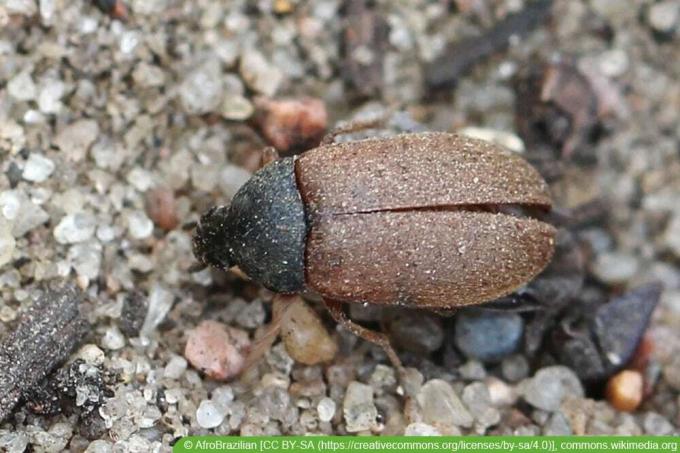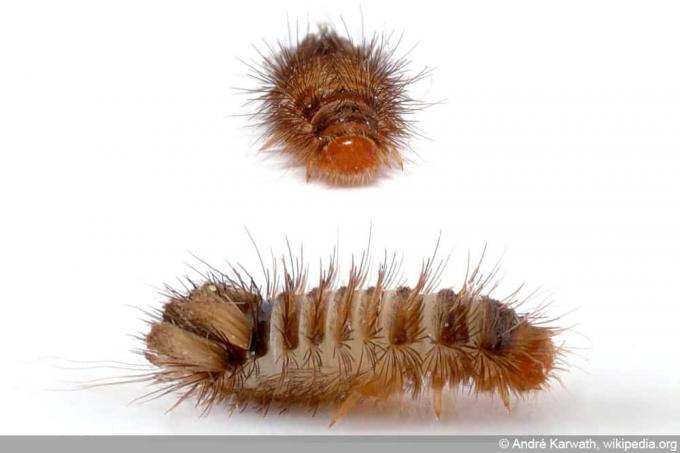

Table of contents
- Meal Beetle (Tenebrio molitor)
- Appear
- harmful effect
- combat
- Fur beetle (Attagenus)
- Common species
- Appear
- damage
- combat
- flour beetle
- Common species
- harmful effect
- combat
- Cockroaches (Blattodea)
- Common species
- Happen
- damage
- combat
- Bacon Beetle (Dermestidae)
- Common species
- Appear
- damage
- combat
- Preventive measures in the house
After a hard day, you look forward to spending time with your family in a beautiful, comfortable apartment. The desire to have dinner together disappears suddenly when one or more black beetles crawl across the floor. Where are you from? Is poor hygiene the cause? Do they transmit diseases? How do you get rid of annoying insects?
Meal Beetle (Tenebrio molitor)
If large black beetles appear in the apartment, they are often flour beetles. The pest occurs in bakeries, grocery stores and farms and can enter homes via flour and grain products as well as dog and cat food.
- length up to 2 centimeters
- shiny black upper side, yellow-brown underside
- yellowish colored larvae (mealworms)
Appear
- wherever grain products and animal feed are stored
- in salt dough handicrafts and arrangements made of dried flowers
harmful effect
- Contamination of grain products and animal feed
- Mealworms transmit tapeworms
combat

Food infested by the flour beetle must be destroyed completely. As soon as flour beetles appear in the apartment, flour supplies and grain products should be checked for the presence of mealworms.
Tip:
When buying groceries, make sure that the packaging is undamaged to prevent the unpopular animals from being brought in.
Fur beetle (Attagenus)
Fur beetles live on trees, bushes, on the ground and on carrion. Fur beetles are attracted to light. They enter the apartment through the open window and cause great damage. Fur beetles destroy textiles, furs and carpets.
Common species
Dark fur beetle(Attagenus unicolor)

- black-brown coloring
- up to 2.8 to 5 millimeters in size
- oval body shape
Brown fur beetle(Attagenus smirnovi)

- dark reddish brown to black colour
- Length 3.5 to 5.5 millimeters
- yellowish hairs on the elytra
- frequent occurrence in apartments with parquet floors
Spotted fur beetle(Attagenus pellio)

- colored black-brown
- light brown spots on the elytra
- Length 4 to 5 millimeters
- Development from egg to beetle takes two to three years
Appear
- households with pets
- Apartments with wide cracks in the parquet or floorboards
- in dried flowers
damage
- Destruction of home textiles, furs and clothing
combat
In the event of an infestation with fur beetles, the apartment must first be thoroughly cleaned. Affected textiles must be disposed of. Textiles are washed at a temperature of at least 60 degrees Celsius to remove beetles, eggs and larvae. Effective insecticides are available in specialist shops.
Tip:
Our grandmothers took advantage of the snow in winter and beat out the carpets in it. This removes dirt and the cold eliminates larvae, eggs and beetles.
flour beetle
The black-brown flour beetle is native to Southeast Asia and is distributed around the world via food exports. Flour beetles are storage pests. They infest flour and grain stocks but also nuts. They can fly well and quickly spread throughout the home.
Common species
Large flour beetle(Tribolium destructor)

- chestnut-brown to black-brown colouring
- very shiny
- Length up to 5.5 millimeters
- Antennae made up of 11 segments
Black flour beetle(Tribolium madens)
- black-brown coloring
- length up to 5 mm
harmful effect
- contamination of flour and grain products
- Release of quinones, which are considered carcinogenic
combat
Infested food must be destroyed. For large inventories, heat treatment is recommended.
A notice:
The quinones emitted by flour flour beetles color flour pink. An unpleasant odor develops. The flour loses its ability to bake and can no longer be processed.
Cockroaches (Blattodea)
Cockroaches appear almost everywhere. They are the best-known storage, material and hygiene pests. More important than the material damage caused by cockroaches is their function as disease carriers. They transmit diseases such as tuberculosis, cholera, dysentery, hepatitis B and typhoid. At the same time, they are suspected of spreading mold. Cockroaches have strong legs and can run fast. The pests develop an unpleasant smell.
Cockroaches are heat-loving insects. They are attracted by the heat of electrical devices, penetrate them and often cause short circuits and defects.
Common species
Australian cockroach(Periplaneta australasiae)

- colored black-brown
- yellowish transverse bundle, yellow wing margin
- Length up to 30 millimeters
Oriental cockroach(Blatta orientalis)

- dark brown coloring
- Length up to 30 millimeters
- Occurs mainly in basements
- activity in the dark
Brown Banded Cockroach / Furniture Cockroach(Supella longipalpa)

- black-brown coloring
- Length 10 to 12 millimeters
- not airworthy
- Occurrence in apartments, hotel rooms
- important cause of allergies
- dangerous disease carrier
Happen
- in food processing plants, restaurants, hotels, hospitals, basements and homes
damage
- disease carriers
- triggers of allergies
- spread of mold
- feeding damage
- bad smell
combat
Cockroaches are fought with feeding bait and sticky traps. Contact insecticides are suitable for use behind cupboards and stoves. The feeding baits must be spread over several months to completely eliminate the pests.
Bacon Beetle (Dermestidae)
Bacon beetles are among the most common hygiene, storage and material pests in homes. While they used to appear mainly in butcher shops, today they are mainly discovered in neglected apartments. Combating them is difficult because bait is not available and insecticides are rarely effective.
Common species
Common bacon beetle(Dermestes lardarius)

- Length 6 to 9.5 millimeters
- two-tone colored wings
Thornless bacon beetle(Dermestes freshi)
- Length up to 6.5 to 10 millimeters
- conspicuous yellow bristles between neck and elytra
Peruvian bacon beetle(Dermestes peruvianus)

- Length up to 10 millimeters
- can fly well
- whitish hairy, shiny wings
- Occurrence in canteen kitchens
Striped bacon beetle(Dermest bicolor)
- Length 7 to 9 millimeters
- deep longitudinal furrows on the wings
Bacon Beetle(Dermestes maculatus)

- Length 6 to 10 millimeters
- Elytra slightly hairy and elongated in a thorn-like manner
Appear
- in polluted homes
- in the trash
- in canteen kitchens
- in textiles, furs, insect collections
damage
- Feeding damage to bacon, meat, cheese, dried fish
- Destruction of insect collections and stuffed animals
- Damage to fur, skins and leather by larvae
- Damage in furniture and floorboards
combat
It is extremely difficult to get rid of bacon beetles in the home. The animals live hidden, so the use of insecticides is often not possible. Bacon beetles are sensitive to very high or low temperatures. The treatment with heat (over 50 degrees Celsius) leads to the death of the animals within a few hours. Cold treatments (below -20 degrees Celsius) require more time. High-quality textiles and furs do not tolerate the heat treatment. They are freed from the pests by a specialist with nitrogen.
Tip:
In apartments with wooden floorboards, sealing the floorboards is recommended to combat the bacon beetle.
Preventive measures in the house
While there is no way to completely prevent large black beetles from appearing in your home, there are effective ways to prevent them.
- Check food supplies regularly
- if larvae and beetles appear, dispose of food immediately
- Seal foods such as flour, cereals, pasta, nuts and dried fruit tightly
- Regularly clean rooms, cabinets, and storage containers where food is stored
- Clean vacuum cleaner
- Install fly screens
- ventilate extensively
- Iron clothes
- only store washed clothes in closets
- Brush, beat, clean carpets
- Clean cracks and corners in the apartment
- Seal parquet and floorboards
- Dispose of kitchen waste quickly
- react quickly when pests appear
- If the infestation is severe, hire a professional pest controller
Danger:
Due to the toxic effect, the use of insecticides in the home is not recommended. In the case of a severe infestation, professional pest controllers can help.
 Home editorial office
Home editorial office
Learn more about home pests

Red maggots / larvae in the apartment: what to do?
Red maggots in your own home are the ultimate nightmare sight. A few crippling seconds of shock are allowed. But then decisive and effective action must be taken to make them disappear. But who exactly is "the red enemy" and how is the fight fought?

Compost bin powder against maggots: this is how it works
Especially in the warm season they can hardly be avoided: maggots in organic waste. In addition to insecticides, there is a far better way to keep the annoying guests away: powdered organic waste bins. We tell you how to use it and how it works.

Combat earwigs | 5 remedies against earworms in the apartment
Although earwigs, Dermaptera in Latin, are completely harmless and actually useful animals, the insects are still a cause for panic for many people when they appear in the apartment. Here you can find out how to get rid of the unloved crawlers.

Ants in the brickwork: you can do that now
Ants are useful insects, if they are in masonry they can cause damage to an object. An infestation is not easy to recognize, but if the first signs appear, you should act immediately. Simple home remedies are usually sufficient to drive away the insects.

Identify and fight fleas in the home
Even the thought of fleas in the home is uncomfortable. After all, we associate uncleanliness with annoying insects. They are considered carriers of dangerous diseases. Where are you from? What are the signs of a flea infestation? How do you get rid of them?

Fighting maggots on the ceiling | 7 tips for all rooms
Bedroom, kitchen or pantry, wall or ceiling - anyone who discovers maggots in the house wants to get rid of them quickly. With our help, you can do it quickly and without professional pest control.

